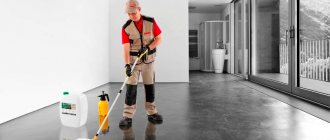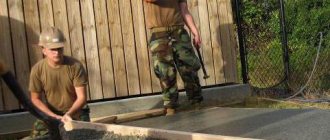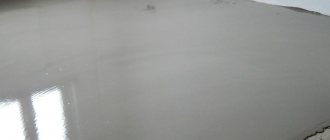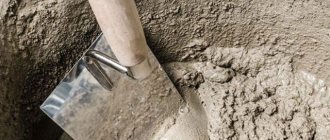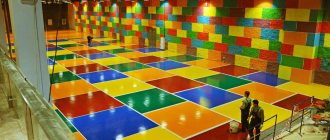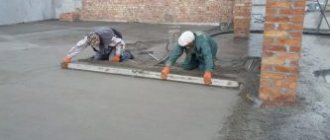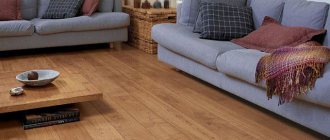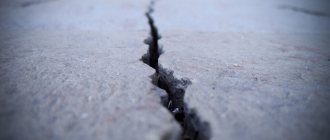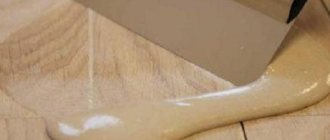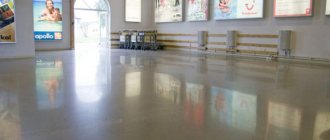The durability of the surface when installing flooring ensures functionality and durability. Concrete floors with a reinforced top layer are characterized by low surface water absorption and chemical resistance. One of the easiest to use and most economical is topping (strengthening with dry or liquid mixtures). The hardening mixture is rubbed into the surface of fresh or old concrete and rubbed with concrete finishing machines to ensure high adhesion. The treatment makes it possible to obtain a high-strength concrete layer with increased wear resistance up to 8 times, as well as reduce dust separation and the quality of the coating.
Types of topping for concrete floors
According to the consistency of the hardening mixture, there are 2 types:
- dry;
- liquid.
Liquid hardener is applied to fresh masonry and to old concrete surfaces. Builders prefer the dry composition and use it exclusively on freshly poured concrete mixture. There are two types of fillers:
- quartz (medium loads of concrete floor);
- corundum (heavy).
Processing with dry mixtures is used for warehouses, garages, and factory workshops with high power loads and vibration or thermal influences. Strengthening the floor is carried out by rubbing the mixture into the top layer:
- high grade Portland cement;
- fillers (microfiber);
- pigments to give color;
- plasticizing additives for easy styling.
You can remove dust from a concrete floor by coating it with varnish, which is applied after grouting.
After grouting is completed, the floor is treated with varnish. The reinforced top layer of floors is characterized by resistance to mechanical damage. The wear of coatings with topping according to GOST 13087-81 is no more than 0.3 g/cm2, compared to standard concrete 0.94 g/cm2. After final hardening, the strength is 50 MPa, and the bending is 9.0 MPa.
The main disadvantages of hardening the top concrete layer include a small choice of color for the finishing layer and low resistance of the coating to chemical influences.
Floors with a reinforced top layer are not used in premises of the food, chemical and medical industries. For this type of building it is better to use polymer coatings (epoxy, polyurethane). The material is applied 3-6 weeks after the completion of concrete laying. And the total work time will take about 2 months, which is not always convenient.
View "GOST 13087–81" or
Technology for installing floors with dry hardener
After pouring the solution and achieving its initial strength, make the first layer of topping.
The construction of a concrete base with a reinforced top layer with a dry mixture includes the following steps:
- Preparation. The surface is leveled, cracks are eliminated, primed, a sand and gravel cushion is applied, waterproofing is carried out and reinforcement is carried out.
- Pouring concrete mixture and compaction. The mixture is compacted with a vibrator along the installed strips of “liquid beacons”.
- Strengthening the concrete surface. They begin to perform it when the concrete reaches its initial strength, if it does not float under the weight of a person (the footprint of the shoe is no more than 2 mm). After the first grout, apply 2/3 of the topping mixture. After the mass has darkened, a second layer is applied to the areas between the columns, next to the walls and near the openings so that the concrete can be well saturated with the released cement milk before the moisture evaporates. After this, the finishing grout is repeated using paddle trowel knives until the surface is mirror-like.
- Protective composition. After the hardening layer, varnish or impregnation is applied. This will give additional strength and rigidity. Impregnation with sealing compounds is carried out using liquid glass. After a day, the layer is treated with a solution of calcium chloride. After completion of impregnation, the concrete is washed with clean water.
- Cutting seams to prevent deformation. The process should be carried out no earlier than 3 days after applying the impregnation.
- Filling with sealant.
- Curing. The concrete is covered with plastic film, moistened or a film-forming compound (curing, sealer) is applied.
Application of liquid hardener
The impregnation is distributed evenly over the entire surface, but not earlier than two weeks after laying the concrete.
In liquid form, the composition is poured onto the surface of the concrete, distributed evenly over the entire strip. The components penetrate deep into the concrete up to 5 mm, where a reaction occurs to form insoluble compounds. Excess liquid is removed from the floor covering. The liquid hardener composition is applied to freshly laid concrete no earlier than 2 weeks from the moment the floor is poured.
Macrofiber polypropylene
- manufacturer: StroFiber
“Fiber” means “fiber”, twisted from several threads (up to 22 pcs.) with a density of 333 tex, distributed throughout the entire volume of the concrete structure, giving it structural elasticity, the ability to absorb tensile...
more details
CleanMaster CM 80 sprayer (acid-resistant) ProControl 100 professional sprayer Double-rotor trowel Barikell MK8-90HCS Single-rotor trowel Barikell 4-120
Mistakes made during work
Organizing the placement, leveling the concrete until laitance appears on it, and correctly assessing the readiness for grouting when hardening the top layer reduces the risk of the hardener peeling off. To eliminate possible detachments, you must:
- Mix cement correctly. Excess water in the cement paste causes deformation of the top layer during the hardening process. If there is not enough moisture, then the drying time of the hardener will increase, and the surface will become loose with unevenly dried areas.
- Clean the surface well. If the substrate is dirty or dusty, then the applied topcoat may peel off.
- If air bubbles appear, smooth the surface with a trowel.
- Protect the finished layer from evaporation by curing or cover it with a polyethylene film to prevent rapid removal of moisture from the surface.
- To install concrete floors, you must use cement of at least M350, and the percentage of entrained air must be less than 3%.
- During the cold season, use additives that accelerate hardening.
The main problem of arranging a concrete floor is the formation of cracks, deformations and chips during shrinkage of the base. This process cannot be completely eliminated by preliminary measures; to reduce this phenomenon, use:
- superplasticizers;
- fiber for reinforcement;
- curings;
- impregnation.
If all processes are carried out correctly, then reinforced concrete floors acquire greater wear resistance, dust formation is reduced, and both decorative and operational properties are improved. And the high oil resistance of the coating prevents concrete from deteriorating when exposed to gasoline and other aggressive chemical elements, which is especially important for underground parking lots and open areas for various uses.
"Cushion" and laying the mixture
First, a kind of “cushion” is created, which is formed from a mixture of sand and crushed stone. Taking into account the groundwater level, its height can vary from half a meter to a meter in height. The difference in surface unevenness should not be more than 2 cm.
To prevent water from washing away the “cushion”, destroying it, and preventing moisture from evaporating, waterproofing work is carried out. In this case, a layer of low-grade concrete is used, forming a thin layer from it. It is covered on top with a waterproofing material, a polyethylene film, 100-200 mm thick. If the work area is large, the surface is reinforced using a metal type of reinforcement.
When laying the mixture, the composition is formed from:
- Cement grade not lower than M300 and class B5, sand;
- Crushed stone and water, in a ratio of 1 to 2 to 4, taking the required amount of liquid, taking into account the moisture content of the composition.
Mixture:
- Poured;
- Level using a vibrating screed;
- They are leveled according to the markings established using beacons.
The thickness of such a base layer is a maximum of 150 mm.
How to harden concrete pavements
Using impregnating compounds
When using chemical hardeners, the technology is not complicated - they are applied to the finished concrete base and evenly distributed over its surface.
Each composition has its own application characteristics and the required state of concrete maturity. This can be an old coating that is being restored, or a freshly laid one with a curing period of about two weeks.
Chemical hardeners penetrate into the thickness of the base to a depth of 3-5 mm, reacting with carbonate and lime components. Typically, after 30-40 minutes, abundant gelation occurs, and the floor is additionally moistened with water to improve absorption. Then, after maximum saturation of the base, the remaining hardener is removed using water, a rag or a squeegee.
Using dry mixes - toppings
The technology of hardening using dry toppings is much more complicated.
First of all, it will make sense if the concrete screed is laid in full compliance with all technological requirements and nuances.
Thus, it must be preceded by careful preparation of the base, thoughtful reinforcement of the concrete screed, compaction of the concrete mixture, including using deep vibrators, and its leveling to the required level using a vibrating screed.
In this case, the grade of concrete used must be at least M-300.
There are also certain requirements for the thickness of the screed to be poured. So, a layer of at least 70 mm is laid on an old concrete base, and if laying is done on a compacted base, then at least 120 mm. In this case, level differences in different places of the room should not exceed 30÷50 mm.
It is better to carry out work at a temperature of 10 ° C and above, or, in case of special need, provide heating of the room with special installations so that the temperature of the screed does not fall below the critical level of +5 ° C. It is necessary to ensure that there are no drafts and prevent the ingress of water , construction dust, etc.
The process itself consists of uniformly distributing the dry composition over the surface of the poured concrete and thoroughly grouting it.
The quality of hardening directly depends on the correctly chosen moment of starting work. Freshly laid concrete requires exposure for initial setting, so that the imprint of the worker’s shoes does not exceed a depth of 4-5 mm. The specific period depends on the temperature and humidity in the room, but usually ranges from 3 to 7 hours.
Initially, about ⅔ of the composition is distributed. This is done either manually or using special carts. As soon as the mixture begins to absorb moisture from the surface of the screed, they begin to thoroughly grout it with special machines - “helicopters”, with discs or “floating” blades installed on them.
It is important to achieve maximum penetration of the mixture into the surface of the screed and saturate it with cement laitance. At the same time, you should not overdry the surface, otherwise you will have to moisten it with water, and this will negatively affect the quality of the coating.
After finishing the first grout, the remaining third of the topping is distributed without any interruption and, after soaking it with milk, grout is also performed.
After the surface has set to a state where the footprint is no deeper than 1 mm, finish grouting is performed.
Then the hardened surface is coated with a special water-retaining varnish or other composition provided for by the specific technology, and the expansion joints are necessarily cut (no later than 6-8 hours after the final grouting), followed by filling them with a plastic sealant after the surface has completely matured.
Topping consumption depends on the requirements for the concrete floor:
- for rooms with light and medium load, 3÷5 kg/m² will be sufficient,
- for medium and high level load - 5÷8 kg/m²,
- and for decorative varieties of topping, the consumption will be about 7÷8 kg/m².
The consumption of metal-containing mixtures can be higher – up to 12 kg.
Lurking errors
When working, you should avoid typical mistakes that can negate the overall hardening of the surface:
- Failure to comply with the start date of work - they try to eliminate this by additionally moistening the concrete surface, which leads to an imbalance in the water-cement ratio and a violation of strength.
- The use, for reasons of false economy, of topping of an inappropriate category, or a significant reduction in its consumption per unit area.
- The use of hardening compounds on concrete that contains plasticizer additives and salt solutions will not have the desired effect.
- Violations of screed reinforcement technology.
- Lack of connection between adjacent maps (fill areas) in the form of embedded connections. As a result, the load during operation is distributed unevenly, and the coating begins to deform.
- Neglecting expansion joints - the process of concrete maturation will be accompanied by surface deformations and cracking.
Application of floors with topping
Industrial floors with a reinforced top layer can withstand loads perfectly and can be installed in parking lots and garages, shopping, entertainment and exhibition complexes, warehouses, as well as in any other facilities where high demands are not placed on the quality of floor coverings. However, the scope of application of floors of this type is limited due to their low resistance to chemicals, as well as the release of a small amount of dust. Therefore, it is best to use polymer coatings in laboratories and medical premises.
Why is concrete hardening required?
First of all, a few words about the structure of concrete. It is a conglomerate mixture, as it consists of several completely dissimilar materials that differ in both chemical composition and size. The crystal lattice of cement stone created during the maturation process is intersected by solid insoluble inclusions of filler - sand or gravel.
If you examine a section of a mature concrete surface under a microscope, you will see that it has a pronounced porous structure - from micropores containing the gel substance of cement to macropores and capillaries filled with unbound water or air, and also having the ability to absorb atmospheric moisture.
Thus, in seemingly monolithic concrete, all three states of matter are always present - solid, gaseous and liquid.
Such a structure inevitably causes erosion processes on the surface of the coating, especially where it is subject to constant mechanical loads, temperature changes, exposure to precipitation or high humidity, and contact with aggressive chemicals.
As a result of erosion of the surface layers of the concrete coating, it begins to dust, crumble, crack, erode, efflorescence, areas of increased looseness, unevenness, etc. may appear on it.
It is almost impossible to completely change the physical and chemical structure of concrete, but to significantly improve the performance characteristics of the coating is a completely feasible task.
For this purpose, a number of technologies are used to harden, remove dust from the concrete surface, grind concrete floors and polish them. All these techniques, as a rule, are closely interrelated and, most often, are carried out in combination. However, it is better to consider them separately, and in this publication attention will be focused on the issues of strengthening the top layer of concrete.
Where hardening of concrete floors is most widely used:
- Production workshops of industrial enterprises.
- Warehouse and logistics complexes.
- Garages and equipment parking.
- Rooms with high humidity or a high probability of exposure to chemical reagents.
- Industrial premises where technology requires completely eliminating contact of cement dust with raw materials or manufactured products, for example, in food industry enterprises.
- Objects of the socio-cultural sphere, education and healthcare, which are characterized by a constant flow of people.
What advantages does the technology bring:
- The wear resistance of the coating increases significantly, and its surface strength increases.
- The floor receives reliable protection from dust formation.
- The water resistance of the coating and its overall moisture resistance increases.
- Service life increases.
- The overall cost of construction work is reduced - it is possible, without losing the quality of the coating, to use concrete of a lower grade.
- The decorative qualities of the concrete floor are improved. Some types of concrete hardeners allow you to create mosaic compositions on floors.
- Maintenance of a reinforced concrete base is much easier.
Strengthening concrete floors with impregnation
Strengthening hardening of concrete, concrete floor
Currently, in industrial and residential construction, various reinforcing impregnations and strengthening impregnations are widely used to strengthen concrete, strengthen concrete, and strengthen screeds. The most effective for strengthening concrete are polymer impregnations, the operating principle of which is as follows: the pores of concrete in the top layer are filled with polymer, modifying this layer into a concrete polymer with improved strength characteristics.
It is obvious that the effectiveness of this technology for strengthening a concrete floor directly depends on the depth of penetration of the strengthening impregnation, that is, on the penetrating ability of the polymer material. Polyurethane hardening impregnations are unrivaled in this parameter.
To solve problems of strengthening concrete floors, we offer the following technologies using Elakor-PU polyurethane materials:
The most commonly used technology. Recommended for strengthening concrete, strengthening floors, strengthening screeds of grade strength M150-M350. Provides an impregnation depth of about 3mm. Allows you to strengthen concrete in the top layer up to M600 or more, regardless of the initial brand strength.
It not only strengthens concrete, but also comprehensively solves most operational problems: it removes dust and seals the base, increases chemical resistance and wear resistance, concrete floors with strengthening impregnation are easily cleaned using any detergents. Can be performed at low temperatures from minus 30 °C.
Characterized by maximum penetrating ability. The impregnation depth for M300 concrete is about 5mm. It solves the same range of problems as the previous technology. Apply at temperatures from 5 °C.
It is used to strengthen concrete on weak (up to M150) foundations, or for maximum strengthening of concrete on “standard” foundations. To increase the penetration depth, it is recommended to cover it with polyethylene film at the time of application (a depth of 5 mm at M150 is provided without covering).
It is also used as a protective coating for substrates with low porosity - the strengthening impregnation is able to penetrate high-strength concrete and damp (but not wet) substrates.
In some cases, the problem of strengthening concrete can be solved by a non-polymer solution:
The most economical option for hardening impregnation. Increases the strength of concrete up to 50%. Increases wear resistance tenfold. Does not change the appearance of the concrete floor, does not form a film on the surface of the base.
The above describes how to strengthen concrete on finished floors, the strength characteristics of which, for one reason or another, do not correspond to the planned loads. Note that all of the above impregnations completely remove dust from a concrete floor, that is, at the same time they are dust-removing impregnations.
To avoid the cost of strengthening the floor screed, it is advisable to achieve the required strength parameters when making a concrete base. For the construction of high-strength bases, we offer complex additives-modifiers for Elakor Elastoconcrete concrete, which make it possible to achieve grade strength M700 and higher only by introducing this material into ready-mixed concrete, without in any way changing the technology of constructing the concrete floor.
Strengthening strengthening of concrete, concrete floor, screed
Currently, in industrial and residential construction, various reinforcing impregnations and strengthening impregnations are widely used to strengthen concrete, strengthen concrete, and strengthen screeds. The most effective for strengthening concrete are polymer impregnations, the operating principle of which is as follows: the pores of concrete in the top layer are filled with polymer, modifying this layer into a concrete polymer with improved strength characteristics.
It is obvious that the effectiveness of this technology for strengthening the floor directly depends on the depth of penetration of the strengthening impregnation, that is, on the penetrating ability of the polymer material. Polyurethane hardening impregnations are unrivaled in this parameter.
To solve problems of strengthening concrete floors, we offer the following technologies using Elakor-PU polyurethane materials:
The most commonly used technology. Recommended for strengthening concrete, strengthening floors, strengthening screeds of grade strength M150-M350. Provides an impregnation depth of about 3mm. Allows you to strengthen concrete in the top layer up to M600 or more, regardless of the initial brand strength.
It not only strengthens concrete, but also comprehensively solves most operational problems: it removes dust and seals the base, increases chemical resistance and wear resistance, concrete floors with strengthening impregnation are easily cleaned using any detergents. Can be performed at low temperatures from minus 30 °C.
Characterized by maximum penetrating ability. The impregnation depth for M300 concrete is about 5mm. It solves the same range of problems as the previous technology. Apply at temperatures from 5 °C.
It is used to strengthen concrete on weak (up to M150) foundations, or for maximum strengthening of concrete on “standard” foundations. To increase the penetration depth, it is recommended to cover it with polyethylene film at the time of application (a depth of 5 mm at M150 is provided without covering).
It is also used as a protective coating for substrates with low porosity - the strengthening impregnation is able to penetrate high-strength concrete and damp (but not wet) substrates.
In some cases, the problem of strengthening concrete can be solved by a non-polymer solution:
The most economical option for hardening impregnation. Increases the strength of concrete up to 50%. Increases wear resistance tenfold. Does not change the appearance of the concrete floor, does not form a film on the surface of the base.
The above describes how to strengthen concrete on finished floors, the strength characteristics of which, for one reason or another, do not correspond to the planned loads. Note that all of the above impregnations completely remove dust from a concrete floor, that is, at the same time they are dust-removing impregnations.
To avoid the cost of strengthening the floor screed, it is advisable to achieve the required strength parameters when making a concrete base. For the construction of high-strength bases, we offer complex additives-modifiers for Elakor Elastoconcrete concrete, which make it possible to achieve grade strength M700 and higher only by introducing this material into ready-mixed concrete, without in any way changing the technology of constructing the concrete floor.
Advantages of topping coatings
Concrete floors with a reinforced top layer have many advantages, including:
- reduction of dust formation;
- increased resistance to shock loads and wear;
- resistance to high and low temperatures, contamination with gasoline and oils;
- large selection of coating colors;
- hygiene and ease of maintenance;
- the ability to obtain ready-to-use flooring in a short time;
- increase in service life;
- favorable price.
